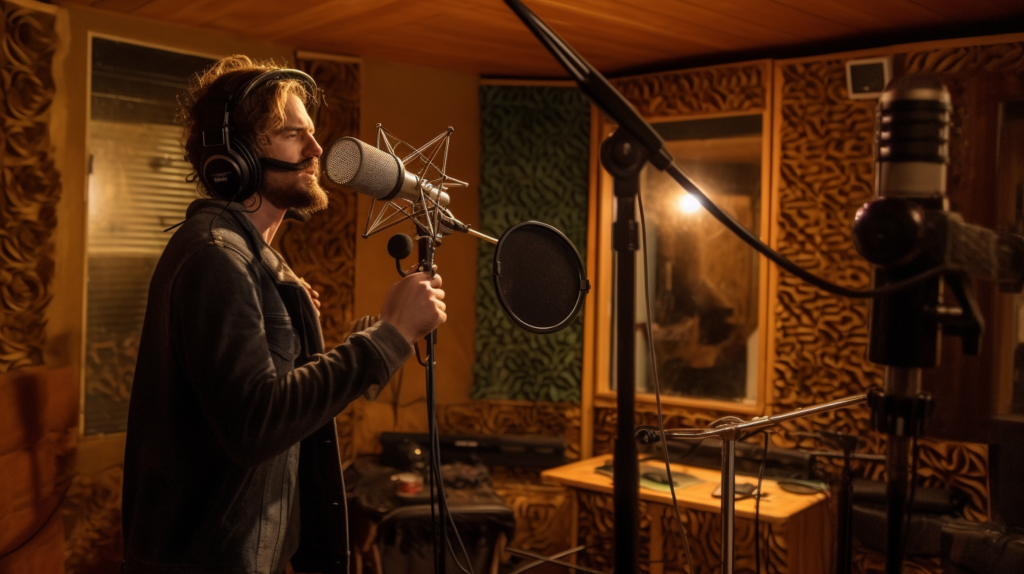
Crafting your own vocal samples for music production is a compelling journey. It’s about sculpting a unique sound that leaves a lasting imprint on the listener. This guide focuses on the process of creating vocal samples, detailing the nuances of sound design, vocal processing, recording vocals, and vocal chops.
Cultivating a Unique Sound: Tapping into the Expressive Potential of Voice in Music Production
Music, at its core, is a medium for conveying emotions, stories, and ideas. And within this realm of expression, the human voice holds a position of prominence. The voice carries a weight of sentiment that resonates deep within us – a cry, a whisper, a song, each of these can stir powerful emotions. When we embark on the journey of creating vocal samples, we’re tapping into this wellspring of expression, seeking to infuse our music production with a unique, emotional resonance. This isn’t just about making sounds that are merely sonically pleasing. It’s about forging a sonic identity that truly reflects our creative instincts and artistic ethos.
Think of your favourite piece of music. What makes it so memorable? Chances are, it’s not just the catchy melody or the thumping beat. It’s the distinctive texture of the voice, the unique timbre that only that artist possesses. That’s the power of the human voice, the unique sound that we strive to capture when creating vocal samples.
Practical aspects
Let’s consider some practical aspects. To begin with, every voice has a natural range of pitch, tone, and volume. When recording vocals, it’s crucial to respect this range. But cultivating a unique sound goes beyond merely recording a voice in its natural state. It requires an understanding of how to alter and manipulate these vocal characteristics to achieve our desired sound.
Another key aspect of cultivating a unique sound is the application of effects. Effects like reverb, delay, distortion, and modulation can drastically transform the character of a voice. They can create a sense of space, add richness and depth, or introduce a sense of unpredictability and excitement. The choice of effects is a matter of personal preference and creative vision. But regardless of the specific choices we make, it’s essential to approach the process with an open mind and a willingness to experiment.
Keep in mind that vocals are not standalone
The art of creating vocal samples is also deeply intertwined with the wider context of the music we’re producing. The vocal samples need to fit within the overall musical structure, complementing the other elements rather than clashing with them. This requires a deep understanding of musical composition and arrangement, as well as a keen ear for balance and harmony.
Lastly, let’s not forget the emotional dimension. When we’re creating vocal samples, we’re not just dealing with abstract sounds. We’re dealing with expressions of human emotion. It’s essential to keep this in mind as we manipulate and transform our vocal samples. The goal should always be to enhance the emotional impact of the voice, rather than detracting from it.
To sum up, cultivating a unique sound when creating vocal samples is a complex and multifaceted process. It requires technical proficiency, a deep understanding of musical principles, and above all, an artistic vision. It’s about listening, experimenting, learning, and ultimately, creating a sound that resonates with our creative instincts. But despite the challenges, the rewards are well worth the effort. For there’s no greater satisfaction than hearing your own unique sound come to life, adding a touch of personal flair to the universal language of music.
Creating Vocal Samples: Step into the Sound Designer’s World
For a music producer, the digital audio workstation (DAW) is the canvas, the palette, and the brush. Sound design is about manipulating this canvas to create unique vocal samples. Using a DAW, we can tweak pitch, adjust timbre, add effects, and layer sounds to create something completely new. But remember, mastering the DAW is just a part of the puzzle. The real key lies in understanding the subtleties of the human voice and how to manipulate it to fit your musical vision.
Techniques of Vocal Processing
Vocal processing is akin to painting with sound. You’re given a palette filled with various sonic colors and it’s up to you to create a masterpiece. It’s a practice that combines the precision of science with the expressiveness of art. As a music producer, this interplay between science and art gives you an unparalleled platform to create unique vocal samples, providing tools and techniques to transform the human voice into an instrument of boundless creativity.
Every voice we record is rich in detail, full of nuances waiting to be explored. Vocal processing allows us to emphasize or minimize these details to suit our musical vision. The first thing to understand is that no two voices are the same, each having a distinct spectral content, dynamic range, and emotional quality. Our task as producers is to shape these voices, enhancing their strengths and mitigating their weaknesses, all while preserving their unique qualities.
The Importance of Mixing Vocals
One of the fundamental tools in vocal processing is equalization (EQ). EQ allows us to adjust the balance of different frequency components within a vocal recording. We can brighten a dull vocal by boosting high frequencies, or remove unwanted low-frequency rumble with a high-pass filter. The use of EQ can be both corrective and creative, serving to fix problems in the recording or to intentionally color the sound.
Next, we have dynamics processing. Compression, limiting, and gating all fall under this umbrella. A compressor helps control the dynamic range of a vocal, ensuring that loud and soft parts are balanced. A limiter prevents the vocal from exceeding a certain volume, while a noise gate can be used to remove background noise during quiet parts of a recording.
Beyond these basics, there are countless effects and processors we can use to transform a vocal in imaginative ways. Reverb and delay can be used to create a sense of space and depth. Distortion can add grit and character, while modulation effects like chorus, flanger, and phaser can create a sense of movement and texture.
Pitch correction tools are often used to correct slight pitch inaccuracies, but they can also be used creatively. For example, extreme settings can create the iconic “auto-tune” effect, transforming the voice into a synthetic, almost instrument-like sound.
Advanced Techniques
Now, let’s delve into more advanced techniques. One powerful tool at our disposal is time-stretching and pitch-shifting. Time-stretching allows us to change the length of a vocal sample without affecting its pitch, while pitch-shifting lets us change the pitch without altering the length. This allows for some wild and creative transformations, such as turning a vocal into a deep, slow drone or a fast, high-pitched chirp.
Granular synthesis is another advanced technique that can yield fascinating results. This involves breaking the voice down into tiny “grains” of sound and rearranging or processing them in various ways. This can create everything from stuttering, glitchy effects to ethereal, cloud-like textures.
Finally, it’s essential to understand that vocal processing is not a one-size-fits-all affair. Different voices and musical styles call for different approaches. It’s about understanding the tools and techniques at your disposal and using them in service of your unique creative vision. It’s about making choices that enhance the emotional impact of the voice and that contribute to the overall musical context.
Vocal processing is a vast field, rich with possibilities for creative exploration. It’s a fundamental part of the process of creating vocal samples, a stage where we can truly put our unique stamp on the sound. With the right balance of technical understanding and artistic intuition, you can turn a simple vocal recording into a vibrant, expressive, and unique vocal sample.
Recording Vocals: Laying the Sonic Foundation for Your Masterpiece
Recording vocals is a gateway to your unique sound, the initial brush stroke on your blank canvas. It’s more than just a technical process, it’s a moment where creativity and technology intersect, bringing the raw vocal material to life. When it comes to creating vocal samples, this stage is crucial. The quality of the recording sets the stage for the subsequent processes of sound design and vocal processing. In this section, we delve into the nuances of recording vocals, from choosing the right equipment to capturing the performance.
Choosing the Right Equipment: Setting Up for Success
Quality equipment is a must when recording vocals. The first item on the list is a good microphone. Condenser microphones are a popular choice for vocals due to their sensitivity and wide frequency response. However, dynamic microphones can also work well, especially if you’re recording loud or energetic performances.
Next, you’ll need a reliable audio interface to convert the analog signal from the microphone into a digital signal that your computer can process. Look for an interface with a high-quality preamp to ensure a clean, noise-free recording.
Lastly, don’t forget the headphones. You need to hear the vocals clearly as you’re recording, so a pair of closed-back headphones is ideal. Here is a good pair of budget studio headphones I use myself. Works well !
Setting Up the Recording Space: The Quest for Clarity
The space in which you record can dramatically affect the sound of your vocal recording. A room with good acoustics can help capture a clean, clear recording, free from unwanted echoes or background noise. Consider using sound-absorbing materials like foam panels to reduce reflections. If you’re recording at home, a walk-in closet filled with clothes can also work surprisingly well.
Preparing the Vocalist: The Human Element
Whether you’re recording your own voice or working with a vocalist, preparation is key. The vocalist should be well-rehearsed and comfortable with the material. Make sure the lyrics or vocalizations are well-practiced, and the vocalist is physically warmed up and hydrated.
Remember, a comfortable vocalist will deliver a better performance. So, take the time to create a positive, relaxed recording environment. Lighting, room temperature, even the position of the microphone, can all affect the vocalist’s comfort and performance.
Capturing the Performance: The Moment of Truth
When it’s time to press the record button, it’s all about capturing the best possible performance. Ensure the vocalist is standing the correct distance from the microphone (generally 6-12 inches) to avoid problems like plosives or sibilance.
During the recording, keep your ears open for any issues. Listen for off-pitch notes, timing errors, or any unwanted noise. If something isn’t quite right, don’t be afraid to do another take. Remember, patience and persistence pay off when it comes to capturing that perfect take.
After the Recording: The First Steps Towards Transformation
Once you have your raw vocal recording, the real fun begins. Now, you can start the process of turning these vocals into unique samples. With your DAW and an arsenal of effects and processors, you’re ready to delve into the realm of sound design and vocal processing.
Recording vocals is a critical part of creating vocal samples, and as you can see, it’s a complex process. It requires technical know-how, an ear for detail, and a sense of musicality. But most importantly, it requires a willingness to experiment and learn. After all, each recording session is a new opportunity to create something truly unique.
Chopping and Slicing: Carving Sonic Sculptures with Vocal Chops
Creating vocal chops is the art of transforming linear, continuous vocal recordings into percussive, rhythmic, and melodic elements. It’s the process of reimagining and reshaping vocal performances into new sonic forms. This technique is a cornerstone in the art of creating vocal samples, giving us the ability to generate dynamic and unique sounds from familiar vocal materials. So, let’s dive deeper into the world of chopping and slicing, exploring how we can create compelling vocal chops for our productions.
Understanding Vocal Chops: Defining the Sonic Canvas
Vocal chops refer to small pieces of vocal recordings that have been cut or “chopped” into segments. These segments, or chops, can be rearranged, looped, and processed to create new musical elements. They can serve as melodic lines, rhythmic elements, or textural accents, contributing to the overall sonic fabric of a track.
Chops offer a flexible and creative approach to using vocals. They can maintain some of the original vocal’s qualities, like pitch and timbre, or they can be transformed until they’re almost unrecognizable. The possibilities are as diverse as your imagination.
Creating Vocal Chops: Mastering the Tools
Creating vocal chops begins with a DAW. You’ll need to familiarize yourself with the editing tools within your DAW of choice, specifically those related to cutting and arranging audio clips.
The first step is to import your vocal recording into the DAW and locate sections that you want to chop. Look for moments with interesting pitch, rhythm, or timbre. Once you’ve selected a section, you can cut it out and begin to manipulate it.
The DAW’s tools allow you to adjust the pitch and timing of each chop, opening up a wide range of creative possibilities. You can stretch or compress the time, transpose the pitch, reverse the audio, or apply various effects. The goal here is to mold the chops into elements that serve your musical vision.
Arranging Vocal Chops: Building a Sonic Mosaic
Once you have a collection of chops, the next step is to arrange them into a musical pattern. This could be a rhythmic loop, a melodic line, or an atmospheric texture. The arrangement process involves a lot of trial and error as you search for combinations that work well together.
One common technique is to pitch different chops to different notes, creating a kind of vocal melody. Another approach is to arrange the chops rhythmically, turning them into a percussive element.
Processing Vocal Chops: Adding the Finishing Touches
Processing is the final step in creating vocal chops. This is where you can apply effects like reverb, delay, distortion, or modulation to further shape the sound of your chops.
This stage is all about experimentation. Try out different effects and settings, always keeping an ear on how they contribute to the overall sound. Remember, the processing should enhance the chops, not overwhelm them.
The Art of Vocal Chops: Finding Your Sonic Signature
Creating vocal chops is an art form in its own right, a process that demands both technical skill and creative vision. It’s about finding the balance between preserving the human quality of the vocals and transforming them into something new and unique.
Creating vocal chops is an iterative process, a cycle of chopping, arranging, and processing. It’s a journey filled with experimentation and discovery, with each iteration bringing you one step closer to your unique sound.
Mastering the art of creating vocal chops opens up a world of creative possibilities, enabling you to create vocal samples that are distinctly yours. So grab your DAW, dive into your vocal recordings, and start carving your sonic sculptures.
Cheatsheet for Producers
| Step | Description |
|---|---|
| Cultivating a Unique Sound | Harness the expressive potential of the voice to sculpt your unique sound |
| Crafting Vocal Samples | Use your DAW to tweak pitch, adjust timbre, add effects, and layer sounds |
| Techniques of Vocal Processing | Explore techniques like EQing, compressing, reverb, delay, pitch correction |
| Recording Vocals | Capture high-quality vocal performances for manipulation |
| Creating Vocal Chops | Slice vocal recordings and reassemble them in a new, creative way |
With a strong understanding of sound design and vocal processing techniques, you’re well-equipped to start creating vocal samples that are uniquely yours. Remember, the rules are not set in stone. There’s ample room for experimentation and creativity in the world of music production.
So, let the journey of creating vocal samples be your playground, where you can experiment, learn, and most importantly, enjoy the process. After all, crafting a unique sound is a deeply personal and rewarding pursuit, akin to creating your own musical language.
Creating vocal samples is just the tip of the iceberg. The world of music production is vast and full of unexplored potential. Keep honing your skills, stay curious, and continue to push the boundaries of what’s possible in sound design. You never know, your unique sound might be the next big thing in the music industry.




